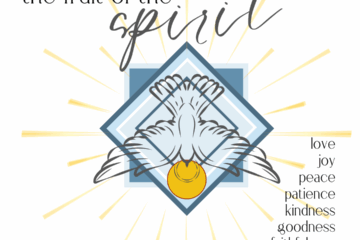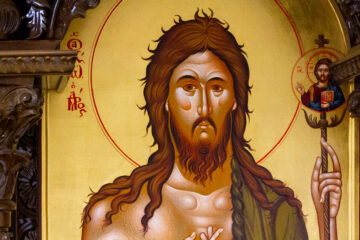The internationally known journalist, cultural critic, and scholar of the English language, H. L. Mencken (1880-1956) of Baltimore, regarded the ninth chapter of St. John’s Gospel as the best crafted short story in all of world literature. It is this chapter (John 9:1-38) that forms the foundation for this Sunday’s remembrance of the man born blind – yet not for its literary character, but for its profound spiritual meaning and message. The story of the healing of the man born blind demonstrates three pairs of symbols that are major Johannine themes: ‘light and darkness’, ‘day and night’, and ‘sight and blindness’ – all of which originate in “light.”
Fr. Clement Muropa, an Alexandrian biblical scholar, notes that “From the Prologue of John’s Gospel until the Resurrection narrative, Jesus is seen and understood as light. The logos (Word) incarnate in Jesus is described as “the light of men” (John 1:14) and where there is light there is truth. Thus, from the beginning, John points out that the logos is and always was the exclusive source of light.”
Jesus not only brings sight and the brightness of day to the blind man, he also shines His light directly into his heart, his history, his motivations, and his anguish – a shining that brought his spiritual conversion. Jesus became light for the man’s mind and revealed Himself as truth-for-believing. The Evangelist wants to show that Jesus is the light and that he gives the light to others, as proclaimed in John 8:12, “I am the light of the world.” Against the darkness of the world, Jesus stands ready to illumine all and expose the truth that will set us free.
The ever-increasing insight of the blind man is contrasted with the ever-hardening blindness of the Pharisees. Their lack of faith in the Messiah was an indication of darkness, a refusal to give assent to Him who was “the life and the light of men.” (John 1:4)
Ironically, it was not his sin or the sin of his parents that caused the man’s blindness. Rather, it was sin (unbridled ego) that caused the Pharisees to become blind to the light, to reject the truth of the light, to prefer instead, the ‘darkness.’ In John 9:5, Jesus says, “As long as I am in the world, I am the light of the world.” St. John Chrysostom writes of this.
“Let us put away, the works of darkness,” he says. Do you see that he tells them that it is night? Wherefore he says, let us walk honestly as in the day, that we may enjoy that light. For if this light be so good, consider what that will be. As much as the sunlight is brighter than the flame of a candle, so much and far more is that light better than this. And signifying this, Christ says the sun shall be darkened. Because of the excess of His own brightness, not even the sun shall be seen. This interplay of light and darkness, truth and ignorance, has practical implications for our own spiritual growth and living.
Jesus Defines the Nature of Illness Within the first seven verses of Chapter 9, Jesus heals the blind man. The bulk of the narrative still remains, verses 8 through 41. Before this, His disciples ask the question: “Who sinned, this man or his parents?”
It was the belief of the Jews that illness and suffering and pain were caused by one’s own sin or the sin of a relative. It was an easy answer to the question “Whose fault is it?”
Jesus, once and for all, gives expression to what would become a fundamental belief of Orthodox Christians: illness, blindness, leprosy, epilepsy, etc. don’t occur because someone committed a personal sin. They are the consequences of the ancestral sin that took place after the mystic wonder of creation. By virtue of our shared humanity, we experience that moral and spiritual disintegration (sickness, brokenness).
Furthermore, Jesus teaches that in the man’s blindness, “the works of God are made manifest in Him.” (John 9:3)
The Lord corrects wrong thinking. He clarifies the fact that all illness is expressive of the “darkness” of the ancestral sin. When the human person (“Adam”) stood over against His Creator, he estranged himself from Him. The shadows of that primordial darkness still abide in us, still haunt us, still point the way to yet more estrangement.
In the words of St. Gregory of Nyssa: “The rejection of the Good (God), once accomplished, had as a consequence the appearance of all forms of evil. By depriving himself of the Light, man fell into darkness.” The one healed by Jesus played his part in salvation history precisely because of his blindness, so that God’s work could be plainly seen and felt.
Christ the Light becomes the One who vanquishes the ultimate effects of sickness, pain, and suffering. He robbed death of its power over us. How do you understand the nature of “blindness” in your life? How does God play a part in your healing? Do you lose hope and yield to discouragement? Most importantly, what are the real shadows of darkness and sin that persist in your life or lifestyle? Are you on the “throne” of your life – or is Jesus?
Conversion to Christ is a Process. Whereas Jesus healed the physical blindness of the man at the outset (verses 1-7), the man’s complete (spiritual) healing did not take place until later in the Gospel passage. Not until the passage was nearly ended (verse 35) did the newly-sighted man make his profession of faith. What happened in between?
Simply put – the more man matured in grace, the more he became aware of who Jesus was. He still had never seen Jesus who sent him off with mud covering his eyes to wash in Silouam. When people first asked him who had healed him, he responded “the man called Jesus.” (v. 10-12)
Some anonymous man had healed him. Later when asked by the legalistic Pharisees who it was that healed him, he said that Jesus was “a Prophet” – someone to be listened to. (v. 13-17) Further interrogation of the parents of the man healed by the Pharisees elicited a still deeper response: “He is a man of God” – meant to be followed, doing the work of God.
And lastly, Jesus Himself encounters the man healed, face to face, looks upon him and asks: “Do you believe in the Son of Man?” The man’s reply: “And who is he, sir, that I may believe in him?” Jesus answers: “You have now seen him and it is He who speaks to you.” The former blind man exclaims “Lord, I believe,” and he worshiped Him.” (v. 34-38)
Faith leads doxology (doxolgia) – confession opens up to worship.
Jesus was at last seen for who He was – the Son of God and God Himself. This great realization on the part of the healed man could only be responded to by glory and praise. The newness of his sight brought a newness to his prayer. The blind man’s faith grew and matured, it was organic, it was developmental. The more he was asked, the more he made that “inner search,” the greater his awareness of Jesus’ identity became. That is the very process of Orthodox asceticism – coming by grace to what God is by nature.
Has your faith grown and matured because of the impact of Jesus on your life? Has religion taken the place of faith for you – like the Pharisees – reducing a genuine living relationship with Jesus to formalities, laws, regulations, structures and concepts? Do I seek to grow in my faith every day or is it something extraneous to my daily living – literally “a Sunday affair”? Am I trying to fill the empty places in my heart with things that the world just cannot and never will give?
If some of the questions for personal reflection above make you uncomfortable, discouraged, or regretful – don’t fear. Questions about one’s faith in God can be unsettling. Facing one’s relationship with Jesus can be daunting. The man born blind lived in that uncertain “darkness,” that shadow-ridden ambiguity, all of his life. He was uncomfortable, hope-drained, discouragement rising.
Many of the Syrian Fathers of the Church interpreted St. John’s passage regarding the healing of the blind man in a different way. They wrote that the man’s blindness was caused because he had a physical deformity with his eyes.
St. Ephraim the Syrian wrote that the blind man in John 9 had been born without any pupils. The miracle, then, was not just a healing, but constitutes a new act of creation. Jesus still creates the wonder of sight today. He can remove darkness and bring light. He can take a tired and worn-out belief and give it new vigor. He can turn religion into faith, an active and on-going relationship with Himself. You and I just need to give in, to conform, to surrender, to take action to allow Jesus to get personally close to us, to allow Him to find us, to touch our eyes that we too, may see! Christ is Risen! Indeed, He is Risen!
ABOUT THE ORTHODOX CHRISTIAN NETWORK
Orthodox Christian Network (OCN) is a 501(c)3 and an official agency of the Assembly of Canonical Bishops of the United States of America .It is a recognized leader in the Orthodox Media field and has sustained consistent growth over twenty-two years. We have worked to create a community for both believers and non believers alike by sharing the timeless faith of Orthodoxy with the contemporary world through modern media. We are on a mission to inspire Orthodox Christians Worldwide. Click to signup to receive weekly newsletter.
Join us in our Media Ministry Missions! Help us bring the Orthodox Faith to the fingertips of Orthodox Christians worldwide! Your gift today will helps us produce and provide unlimited access to Orthodox faith-inspiring programming, services and community. Don’t wait. Share the Love of Orthodoxy Today!
Categories: ArticlesAll Articles


0 Comments